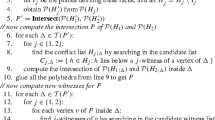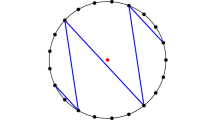Abstract
The procedure described here employs face-to-face intersection analysis to determine whether two or more polyhedral objects intersect. As means to minimize the number of pairs of faces which should be examined for face-to-face intersection analysis, a solution box approach, mutual divisibility, and visibility of two faces are considered. Intersection detection between two faces is done by the determination of their parity mode.
Similar content being viewed by others
References
Paul G. Comba, “A procedure for detecting intersections of three-dimensional objects,”J. ACM 15(3): 354–366 (1968).
Charles M. Eastman, “Representation for space planning,”Comm. ACM 13(4): 242–250 (1970).
H. Freeman, “On the encoding of arbitrary geometric configurations,”IRE Trans, on Electronic Computers EC-10: 260–268 (1961).
W. E. Howden, “The sofa problem,”Computer J. 11(3): 299–301 (1968).
Y. S. Luh and R. J. Krolak, “Mathematical model for mechanical part description,”Comm. ACM 8(2): 125–129 (1965).
K. Maruyama, “A procedure for detecting intersections and its application,” Department of Computer Science, Report No. 449, University of Illinois, May 1971.
E. F. Moore, “On the shortest path through a maze,”Proc. Int. Symp. on the Theory of Switching, Harvard University, Harvard Annals, Vol.3 (1959), pp. 285–292.
T. Nicholson, “Finding the shortest route between two points in a network,”Computer J. 9: 275–280 (1966).
Ira Pohl, “Bidirectional and heuristic search in path problems,”SLAC Report, No. 104, May 1969.
L. G. Roberts, “Machine perception of three-dimensional solids,” Ph.D. Thesis, MIT, May 1963.
I. E. Sutherland, “A method for solving arbitrary-wall mazes by computer,”IEEE Trans. on Computers C-18(12): 1092–1097 (1969).
John E. Warnock, “The hidden line problem and the use of halftone displays,” University of Utah, Computer Science, March 1969.
D. E. Whitney, “State space models of remote manipulation tasks,” Ph.D. Thesis, MIT, January 1968.
L. A. Lyusternik,Convex Figures and Polyhedra, translated and adapted from the first Russian edition (1956) by D. L. Barnett (D. C. Heath and Co., Boston, 1966).
Author information
Authors and Affiliations
Additional information
This work was supported in part by the Department of Computer Science at the University of Illinois at Urbana-Champaign, Urbana, Illinois; the National Science Foundation under NSF Grant GJ-328.
Rights and permissions
About this article
Cite this article
Maruyama, K. A procedure to determine intersections between polyhedral objects. International Journal of Computer and Information Sciences 1, 255–266 (1972). https://doi.org/10.1007/BF00977413
Revised:
Issue Date:
DOI: https://doi.org/10.1007/BF00977413




